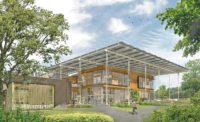Applying Advanced Integrated Practice Principles
The list of co-authors writing the AIP book is a group consisting of owners, designers and construction professionals, each with a vast amount of experience and knowledge of procuring, managing, designing, constructing and working within simple, as well as complex multifaceted projects. All along it was the consensus of the group that collaboration, innovation and integration were paramount in defining concepts and techniques that would define “advanced integrated principles.” Additionally, it was also felt that in order to establish AIP as a new standard, the process should not be limited to just one operational methodology, rather, it was to be used and applied to CMAR, design-build and IPD contracting strategies for projects. To that end, the team discussed and established methods and techniques which were the most proven and provided the best results. To set the stage, the team established how the book would address a project, from concept to completion, using these AIP methods.
In order to validate these renewed and proven concepts, each chapter includes a case study that discusses the concepts used, and points out how it relates to the methods, techniques or processes discussed in that chapter and how it met the needs and goals of the project. The project selected for each chapter was none other than the award winning Department of Energy National Renewable Energy Laboratory - Research Support Facilities, located in Golden, Colo.
The project is a LEED Platinum, net-zero research facility which utilized a design-build delivery method and was the first truly integrated, innovative and collaborative project for the U.S. Department of Energy. The RSF is a laboratory and data center as well as one of the newest sustainable green buildings — a 222,000-sq-ft facility that is a showcase for energy efficiency and renewable energy technologies. It includes a rooftop photovoltaic system that was implemented through a power-purchase agreement, daylighting, natural ventilation, and a next-generation, energy efficient data center. The RSF has won numerous awards for its innovative design, construction, and sustainable features.
Through such examples and many others, the book frames why change is necessary, as well as explaining the pressure for change and the inhibitors to change, all which establishes the need to use these suggested methods defined in the book. It goes on to discuss the future state and how integrated practice creates value, for not only the owner, but also the designer and constructor.
It is important to note that collaboration and culture really establish how the teams communicate and work together, as well as how the owner interacts with not only the designer, but the constructor early in the life of the project. The chapters define team goals and project values and promote how the team establishes and meets the owner’s one true vision for the project.
In short, Advanced Integrated Practice - “Create a Culture of Deep Collaboration,” is a valuable reference tool for not only owners, but all construction teams because it provides highlights of the challenges and solutions prevalent on today’s job sites and in planning offices by providing concepts and processes to integrate advanced integrated practice on simple and complex multi-faceted projects.
Change is necessary in all industries and is overdue in construction. Developing an advanced integrated practice brings value to all projects through technology, innovation and integrated processes while also looking to the future state of the construction industry.
Research links:
“Integrated Project Delivery: A Guide”, 2007 by the AIA National / AIA California Council, 2007
“Integrated Information, and the Project Lifecycle in Building Design, Construction and Operation”, a whitepaper (No. WP-1201), August 5 2004, published by CURT (Construction Users Roundtable)
”Why Construction Industry Productivity is Declining,” by Steven G. Allen, National Bureau of Economic Research no. 1555, Feb., 1985. Retrieved 2008-11-17
“Regional Productivity Growth in U.S. Manufacturing: 1951-78”, by Charles R. Hulten and Robert M. Schwab, The American Economic Review, Vol. 74, No. 1 (Mar., 1984), pp. 152-162, Published by: American Economic Association
“From Continuous Improvement to Continuous Innovation, and Subsequent Discussions,” a whitepaper by Robert E. Cole, University of California – Berkeley, ASQ2001
Arnold R. Canales is a construction industry consultant and principal of ARC Consulting, providing engineering and construction support to engineering and construction companies, including PreCon Services, Project Management and augmented mechanical design. For more information, on AIP, visit http://www.ace4aec.com.








